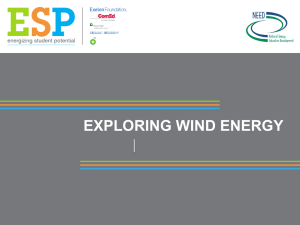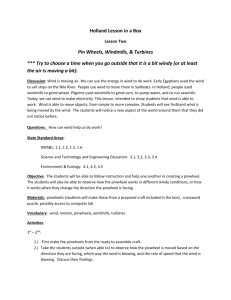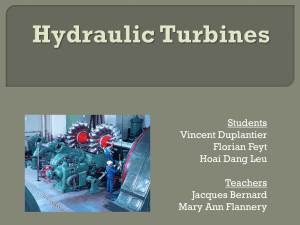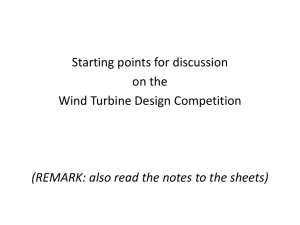Introduction to Wind Energy
advertisement
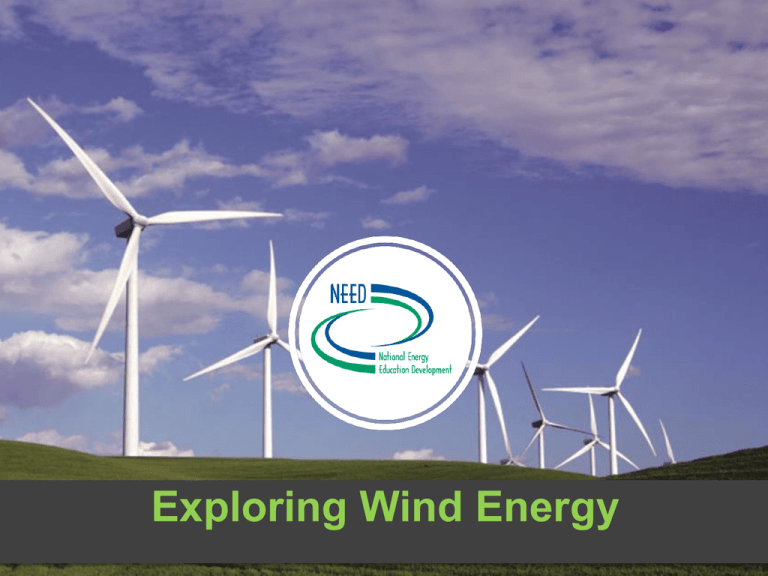
Exploring Wind Energy What Makes Wind Global Wind Patterns History of Wind Energy 5000 BC Sailboats used on the Nile indicate the power of wind 500-900 AD First windmills developed in Persia 1888 Charles F. Brush used windmill to generate electricity in Cleveland, OH 1985 CA wind capacity exceeded 1,000 MW 1300 AD First horizontalaxis windmills in Europe Early 1900s Windmills in CA pumped saltwater to evaporate ponds 1850s Daniel Halladay and John Burnham build Halladay Windmill; start US Wind Engine Company 1941 In VT, Grandpa’s Knob turbine supplies power to town during WWII 1993 2004 US WindPower developed Electricity from first commercial variable-speed wind generation wind turbine costs 3 to 4.5 cents per kWh Late 1880s Thomas O. Perry conducted 5,000 wind experiments; starts Aermotor Company 1979 First wind turbine rated over 1 MW began operating 2011 Wind power provided over 12% of renewable energy used in US Why Wind Energy? o Clean, zero emissions - NOx, SO2, CO, CO2 - Air quality, water quality - Climate change o Reduce fossil fuel dependence - Energy independence - Domestic energy—national security o Renewable - No fuel-price volatility Renewable Electric Capacity Worldwide The NEED Project 2014 US DOE, EERE 2012 Renewable Energy Data Book US Electricity Generation from Non-Hydro Renewables 300 Geothermal 250 Waste Wood Solar Thermal Million kilowatt-hours 200 Solar Photovoltaic Wind 150 100 50 0 1990 1995 2000 2005 2010 2011 2012 2013 Top Installed Wind Power Capacity THE TOP TWENTY-FIVE STATES for Installed Wind Capacity, in MW as of December 31, 2012 1 Texas 12,212 14 Pennsylvania 2 Iowa 5,549 15 Michigan 988 3 California 5,137 16 Idaho 973 4 Oregon 3,153 17 South Dakota 784 5. Oklahoma 3,134 18 New Mexico 778 6. Minnesota 2,986 19 Wisconsin 649 7 Washington 2,808 20 Montana 645 8. Kansas 2,712 21 West Virginia 583 9 Colorado 2,301 22 Missouri 459 10 North Dakota 1,679 23 Nebraska 459 11 New York 1,638 24 Maine 431 12 Indiana 1,543 25 Utah 325 13 Wyoming 1,410 The NEED Project 2014 1,340 National Renewable Energy Laboratory Annual Installed U.S. Wind Power Capacity AWEA U.S. Wind Industry Annual Market Report Year Ending 2013 Installed Wind Capacities 1999-Present Total: 61,946 MW As of 6/30/2014 1999 Total: 2,500 MW Top Twenty States for Wind Energy Potential Rank State 1 Texas 2 Potential Installed Capacity (MW) Rank State Potential Installed Capacity (MW) 1,901,530 11 New Mexico 492,083 Kansas 952,371 12 Minnesota 489,271 3 Montana 944,004 13 Colorado 387,220 4 Nebraska 917,999 14 Missouri 274,355 5 South Dakota 882,412 15 Illinois 249,882 6 North Dakota 770,196 16 Indiana 148,228 7 Iowa 570,714 17 Wisconsin 103,757 8 Wyoming 552,073 18 Michigan 59,042 9 Oklahoma 516,822 19 Ohio 54,920 10 Alaska 494,703 20 California 34,110 U.S. Wind Resource Map Transmission Challenges China Leads the World in Wind Capacity Total Installed Generating Capacity (MW) Top 5 Countries for 2013 New Installed Capacity 1. China 2. Germany 3. United Kingdom 4. India 5. Canada Why Such Growth? …costs are low! • Increased Turbine Size • R&D Advances • Manufacturing Improvements 1979 40 cents/kWh 2000 4-6 cents/kWh 2004 3-4.5 cents/kWh 2011 Less than 5 cents/kWh Modern Wind Turbines Turbines can be categorized into two classes based on the orientation of the rotor. The NEED Project 2014 Vertical-Axis Turbines Advantages Disadvantages o Omni-directional - accepts wind from any direction o Components can be mounted at ground level - ease of service - lighter weight towers o Can theoretically use less materials to capture the same amount of wind o Rotors generally near ground where wind is poorer o Centrifugal force stresses blades o Poor self-starting capabilities o Requires support at top of turbine rotor o Requires entire rotor to be removed to replace bearings o Overall poor performance Horizontal-Axis Wind Turbines Small (<10 kW) oHomes oFarms oRemote Applications (e.g., water pumping, Telecom sites, ice making) Intermediate(10-250 kW) oVillage Power oHybrid Systems oDistributed Power Large (250 kW-2+ MW) oCentral Station Wind Farms oDistributed Power oSchools Large Wind Turbines Common Utility-Scale Turbines 328’ base to blade Each blade is 112’ 200 tons total Foundation 20’ deep Rated at 1.5-2 megawatts o Supply about 500 homes o o o o o Wind Turbine Components How a Wind Turbine Operates The NEED Project 2014 Installation of Wind Turbines The NEED Project 2014 Wind Turbine Perspective Workers Blade 112’ long Nacelle 56 tons Tower 3 sections The NEED Project 2014 Wind Farms Offshore Wind Farms Residential Wind Systems and Net Metering Potential Impacts and Issues Property Values Noise Visual Impact Land Use Wildlife Impact Properly siting a wind turbine can mitigate many of these issues. Impacts of Wind Power: Noise The NEED Project 201 Wildlife Impacts For More Information The NEED Project www.need.org info@need.org 1-800-875-5029 Energy Information Administration U.S. Department of Energy www.eia.gov The NEED Project 2014
